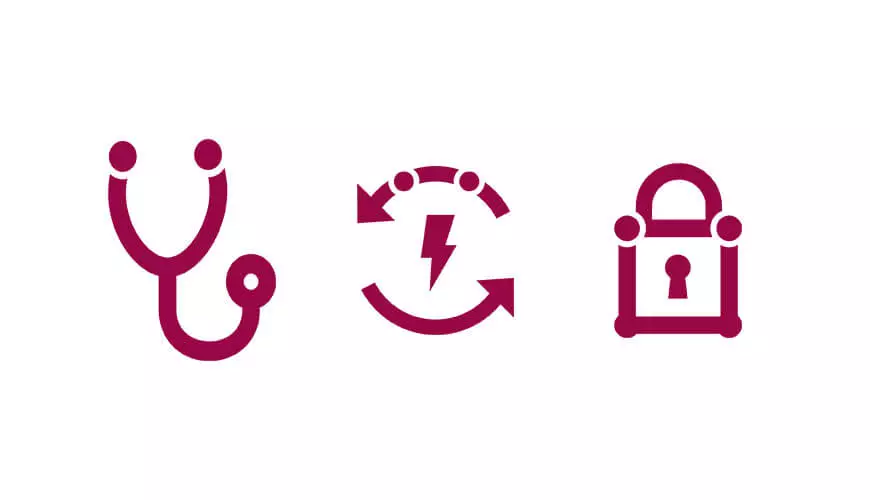It’s important to regularly review your organisation’s spend on IT services, perhaps more so than other services within the business due to the ever-changing nature of technology.
We have put together a list of the 10 most common ways businesses waste money on IT, which will hopefully help you when it comes to sitting down and assessing your spend on technology.
Whilst this isn’t an exhaustive list, we think it covers some of the most common issues, a lot of which are relatively painless to put into action.
Download the free IT cost saving checklist
1. Holding on to and overpaying on unnecessary software licensing fees
If you use technology in any capacity, there’s no doubt that you’ll have paid for, or be paying for software and licensing fees that come with it. There are generally two types of payment methods for software:
- One-off purchases: often referred to as ‘perpetual licenses’ are licenses that do not expire.
- Recurring payments: usually known as ‘subscription licenses’ are where you pay for what you use for as long as you use it.
Perpetual licensing used to be the norm before the use of cloud applications really took off. Usually these types of licenses are sold with a subscription of some sort, often in the way of support or access to the software’s latest updates.
Subscription payments are becoming more and more popular and for good reason, but it’s very easy to start overpaying without realising it. In the case of services such as Microsoft Office 365, many small payments can quickly add-up and so it’s important to routinely audit your license usage.
What can I do about it today?
- Audit your license usage: ask your IT staff for a list of users and who has what license. Remove any unnecessary licenses and archive their data.
- Check your invoices: compare these with your expected license usage and query any differences. Often you end up paying for old and dormant accounts and services.
- Ask your IT team to break down the features included in each software subscription – check if you need what you’re paying for. Often, you can use a lower cost option with fewer features
2. Holding onto old IT infrastructure hardware
In the last few years, the advent of cloud technology and virtualization has meant that significantly less hardware is required to host your critical business applications and databases. It used to be the case that a physical server was required to run each workload – but not anymore. Today, it’s possible to host multiple servers on a single piece of hardware.
Using multiple physical servers only costs you money and is more expensive just about every way you look at it. Power, cooling, licensing, downtime risk, backup and support costs all see huge gains.
What can I do about it today?
- Ask your IT staff for a breakdown of what the cost saving would be by virtualizing all of your physical servers into a single virtual server, then ask for an idea of costs to get there.
- Can you move any of your workloads to the cloud, or use a different service? By moving just one workload off a server you can often make that server redundant.
- Speak to the experts! Your IT staff, whether they are employed by you or contracted to you, should be more than happy to help with this type of discussion.
3. Hosting and running your own software and applications
Over the last five years, global improvements in internet connectivity has led to the rise of cloud technology. One of the largest uses of the cloud is software deployed over the internet without the need for anything onsite, other than an internet connection. Notable business services that have been very successful in this type of delivery include Microsoft Office 365, SalesForce CRM, GSuite, NetSuite, Slack and Zoom.
If you’re still hosting your own software on servers within your premises, there’s a good possibility you can significantly lower your spend.
As time goes on, and cloud services continue to improve, there’s a very good chance that all common workloads run by businesses will have a ‘software as a service’ offering, and their on-premises counterparts could die out.
What can I do about it today?
- Audit the software your teams use and build a list. Ask your IT team, your contacts and do some research. For every software application there are often five more which do a similar job.
- Ask your IT staff for an idea of costs saved by decommissioning your onsite applications then compare these with the subscription fees of the cloud alternative.
4. Backing up unwanted and unnecessary data
If you’re like most businesses today, you probably utilise the cloud for your disaster recovery process in some way. Cloud backup is by far the most common method, in which your key IT workloads are backed up routinely to an offsite datacentre.
Whilst this is a great use of cloud technology, it’s crucial to ensure that your costs aren’t running away. The key here is to remember that your costs are directly linked to your usage; the more your backup, the higher your costs, down to the single GB of data.
What can I do about it today?
- Review a report on usage – by reviewing a data audit listed by size and capacity, you can quickly spot anything out of place. One example is if your organisation uses ‘redirected folders’, which means each person’s ‘My Documents’ are moved to the server to protect against data loss. All well and good, until someone decides to upload their family photos and your next month’s backup charge is twice as high!
- Ask your IT team what your retention policy is for cloud backup; do you really need to be storing 30 days’ worth of backup in the cloud? This is expensive, can you make use of onsite storage for retention instead?
5. Over provisioning your cloud servers
If you are a business that utilises one of the many cloud platforms for hosting your servers, then you’ll understand the nature of subscription payments and how important it is to keep on top of things.
We managed to reduce an organisation’s cloud infrastructure costs by a whopping 50% by moving them to a more competitive platform from a provider who hadn’t been offering any due diligence on their usage.
All good cloud providers, including the three big public cloud providers Microsoft, Amazon and Google, have intricately detailed usage reports available from your account. Bandwidth, storage and the incorrect server specification are some of the most common ways that customers using their services over spend.
What can I do about it today?
- It’s best to have an expert look over this, but there’s an awful lot of information to be gleaned from your usage reports. Common things to look out for are storage allocations, bandwidth and sever specifications. With storage allocation, you need to check whether you are paying for large amounts of storage sitting empty within your servers; with bandwidth detailed analysis of the amount of data downloaded can be insightful because most providers charge per GB, and with server specification you need to check you’re are not using a server that is more powerful than necessary – a lower spec would reduce costs.
- Enquire with your provider about reservations – most good cloud providers will give you the option to ‘reserve’ your servers by paying upfront and will often provide great savings. For example, within Microsoft’s Azure platform, you can save around 45% by purchasing three years upfront. Just be sure your specification isn’t going to go down – you can increase, but you can’t reduce mid-term.
6. Running old servers
This one is a favourite of ours, as it’s everywhere! Many organisations don’t realise the cost/benefits of replacing their old server infrastructure when the time comes, and instead favour the ‘if it ain’t broke’ approach. Whilst it’s an admirable approach, the key is always to remember that technology evolves faster than any other market sector. A top of line piece of IT hardware from five years ago will often under perform against an entry level piece today.
The same applies with servers and the consequence is lost revenue. If you’re experiencing slow applications, file open times, crashes, bad file transfer speeds or other similar symptoms, there is a very good chance it’s caused by the software and systems you’re using outdating what the hardware in your server room is capable of.
What can I do about it today?
- Your IT staff will nearly always be very keen to discus new hardware; after all, it makes their jobs easier. Discuss with them what the symptoms are of your ageing server and use the information they provide to make an informed decision about whether it’s worthwhile investing in a replacement or moving to the cloud.
7. Running old computers
Often harder to detect without monitoring and tracking tools, but potentially just as costly for your organisation. Using workstations past their recommended shelf-life date (typically around four to five years) will be detrimental to the productivity of your staff and ultimately your bottom line.
What can I do about it today?
- Audit your computers. Your IT staff should be able to produce something like an asset report for all workstations in the organisation, listing the purchase date and warranty expiration.
- Replace any computers that are over five years old.
8. Purchasing unnecessarily powerful workstations
When it comes to buying a new laptop or desktop for your staff, it’s important to make sure it’s an informed purchase. Many times, staff with roles in the company that only require a basic level of technology end up with a powerful computer that’s capable of handling much more than necessary. There aren’t any performance gains for unused resources on the computer, so ensure you work with your IT team on making the best purchase decision.
What can I do about it today?
- Work with your IT team on looking at the best specification to match the job role. It can be useful to save these specifications for future purchases for the same role.
- Review staff IT requirements regularly. A good IT team will have historical resource logs for each computer, which is invaluable for making good purchasing decisions.
9. Taking on and retaining expensive IT staff
Highly skilled IT staff can be an attractive prospect for your business, but at a significant cost. An experienced and highly qualified IT systems administrator’s salary can easily run into six figures. Whilst there is certainly not a ‘one size fits all’ structure for an organisation’s IT support provision, it’s important to think very carefully about taking on staff, particularly recruits demanding a top salary.
What can I do about it today?
- Ask yourself if you really need such a high level of expertise in-house. Speak to your contacts, what are their experiences?
- Seriously consider outsourcing at least a portion of your IT provision to an external company. This can prove much more cost effective and often land you with a better service without the hassle of retaining skilled staff.
10. Not using the correct internet connectivity
Many organisations are spending needlessly on outdated connectivity contracts. Furthermore, often the type of internet connection isn’t appropriate for the organisations demands – from ADSL connectivity delivered at very low cost over your telephone line, to dedicated high-speed gigabit fibre straight into the building, it’s crucial to establish usage and adjust your contracts accordingly.
What can I do about it today?
- Speak to your IT team or your internet provider about usage. Work out what your average usage is from the past six months and consider if something different might be more appropriate.
- Re-evaluate the market at the end of your contract – connectivity has been falling in price every year, be sure you take advantage of this!
Conclusion
Whilst this isn’t an exhaustive list, we’ve found these 10 points to be incredibly effective at bringing IT operational costs under control. We’ve spent many years working with businesses like yours and have a good understanding of where the most common holes are – and how to patch them up!




